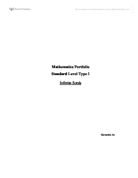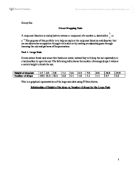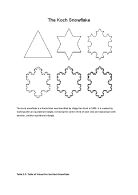Mathematics portfolio on Infinite Surd
Mathematics Portfolio Standard Level Type I Infinite Surds Germaine An A surd is a sum with one or more irrational number expressed with a radical sign as addends. Examples are 1+V3, V2+V3, and V(1+V(1+V1)). Therefore, an infinite surd has an infinite number of such addends. An example is in the diagram. The following expression is an example of an infinite surd. Consider this surd as a sequence of terms an where: ==1.414213562 ==1.553773974 ==1.598053182 ==1.611847754 ==1.616121207 ==1.617442799 ==1.617851291 ==1.617977531 ==1.618016542 ==1.618028597 According to the result, you can aware that a2 = Then analyzing the formula, an+1 = On the graph, it represents that at the point of the beginning it raises rapidly as acceleration. However, after that, an-an+1 value has been had no huge change which means that difference is close to 0. Apply Here is a proved formula a= a2=1+a a2-a-1=0 Use quadratic equation a= = 1.618033989 or -0.6180339887 However, the root cannot be the negative number So, ? 1.618033989 Consider another infinite surd where the first term is Repeat the entire process above to find the exact value for this surd. ==1.847759065 ==1.961570561 ==1.990369453 ==1.997590912 ==.1999397637 ==1.999849404 ==1.999962351 ==1.999990588 ==1.999997647 ==1.999999412 According to the result, you can aware that = Then
Infinite Surds portfolio
Internal Assessment number 1 Nazha AlFaraj Ms. Leana Ackerman IB Mathematics SL (year 2) Sunday, February 19, 2012 Infinite Surds This following expression is known as an infinite surd. V1+V1+V1+V1+... The previous infinite surd can be changed into the following sequence: a1= V1+V1= 1,414213 a2= V1+V1+V1= 1,553773 a3= V1+V1+V1+V1= 1,598053 a4= V1+V1+V1+V1+V1= 1,611847 a5= V1+V1+V1+V1+V1+V1= 1,616121 a6= V1+V1+V1+V1+V1+V1+V1= 1,617442 a7= V1+V1+V1+V1+V1+V1+V1+V1= 1,617851 a8= V1+V1+V1+V1+V1+V1+V1+V1+V1= 1,617977 a9=V1+V1+V1+V1+V1+V1+V1+V1+V1+V1= 1,618016 a10= V1+V1+V1+V1+V1+V1+V1+V1+V1+V1= 1,618028 The first 10 terms can be represented by: an+1= V1 + an If we graph the first 10 terms of this sequence we can show that the relationship between n and L can be represented by L= an The data begins to increase by a smaller amount about each consecutive n, suggesting that the data may be approaching as asymptote. As these values get very large, they will probably not get much higher than the value of a10, because there already appears to be almost horizontal trend. The data also suggests that the asymptote is between the value of 6 and seven, although to find the exact value requires a different approach The graph clearly shows that the value of L gradually moves approximately towards 1,618, but it will never reach that number. Furthermore, the relationship
Crows Dropping Nuts
Jimmy Cui Crows Dropping Nuts A reciprocal function is multiplicative inverse or reciprocal of a number x, denoted by or x -1.The purpose of this portfolio is to help us explore the reciprocal function and discover that we can determine an equation through trial and error by making an educated guess through knowing the rule and patterns of the parameters. Part 1- Large Nuts Crows cannot break nuts since their beaks are weak, instead they will drop the nut repeatedly on a hard surface to open the nut. The following table shows the number of average drops it takes at a certain height to break the nut. Height of drop(m) .7 2.0 2.9 4.1 5.6 6.3 7.0 8.0 0.0 3.9 Number of drops 420 21.0 0.3 6.8 5.1 4.8 4.4 4.1 3.7 3.2 This is a graphical representation of the large nuts data using TI InterActive. Relationship of Height of the drop vs. Number of drops for the Large Nuts The variables in this data are that the height of the nut dropped affected the frequency, and this variable is put into an average. Another variable is the frequency of drops is also an average, where it is impossible to have 6.8 times of drops to open a nut. This has been converted into an average because it provides much clearer data, which could be put into one graph and distinguish the equation for it. Another variable is the size of the nut, since it takes a higher number of drops
Matrices Portfolio
A matrix is a rectangular array of numbers (or letters) arranged in rows and columns. These numbers (or letters) are known as entries. Entries can be added and multiplied, but also squared. The aim of this portfolio is to investigate squaring matrices. When we square the matrix M = what we receive is a) = = . Calculating the matrices for n = 3, 4, 5, 10, 20 and 50: = = = = = = Examples shown above clearly indicate that while zero entries remain the same, non-zero entries change. Each entry is raised to a given power separately. Raising them to any power does not change the zero-entries. Hence, we can observe that the general expression for the matrix = = When considering the matrices P = and S = , more conclusions can be drawn. Raising each of them to the second power gives: = = = 2 = = = 2 These matrices are simplified to 2 and 2 to make it easier to notice any patterns. Calculating Pn and Sn for other values of n we obtain: = = = 2 = 4 = = = 2 = 4 = = = 2 = 16 = = = 2 = 16 = = = 512 = = = 512 Analysis of above pattern shows that: a) dividing the first result by 2 raised to the power 1 less than the number to which the matrix is raised (e.g. P10; number 2 will be raised to 10 - 1 = 9 power, which gives 512), results in a new matrix with two pairs of similar entries situated diagonally; b) the difference between two
Infinite Surds
March 9, 08 Infinite Surds .) (V1+V1+V1+V1+...) A1 V1+V1 .4142 A2 V(1+ A1) .5537 A3 V(1+ A2) .5980 A4 V(1+ A3) .6118 A5 V(1+ A4) .6161 A6 V(1+ A5) .6174 A7 V(1+ A6) .6178 A8 V(1+ A7) .6179 A9 V(1+ A8) .61801 A10 V(1+ A9) .61802 > As n increases, An also increases, however when n gets very large An - An + 1 > An = V(1+ An -1) > An+1 = V(1+ An ) An = V(1+ An -1) An = V(1+ An ) An2 = 1 + An Quadratic formula : a = 1 b = -1 c = -1 An = -b ±V(b2-4ac) / 2a An = 1 ±V(-1)2-4(1)(-1)) / 2(1) An = 1 ±V(5) / 2 a.) 1 +V(5) / 2 b.) 1 -V(5) / 2 < 0 c.) answer: 1 +V(5) / 2 An2 - An - 1 = 0 : As n gets very large An - An-1 = 0 ; An = An-1 2.) V(2+V2+V2+V2+...) A1 V2+V2 .8477 A2 V(2+ A1) .9615 A3 V(2+ A2) .9903 A4 V(2+ A3) .9975 A5 V(2+ A4) .9993 A6 V(2+ A5) .9998 A7 V(2+ A6) .99996 A8 V(2+ A7) .99999 A9 V(2+ A8) .999997 A10 V(2+ A9) .999999 > As n increases, An also increases, however when n gets very large An - An + 2 > An = V(2+ An -1) Therefore: > An+1 = V(2+ An ) An = V(2+ An -1) An = V(2+ An ) An2 = 2+ An Quadratic formula : a = 1 b = -1 c = -2 An = -b ±V(b2-4ac) / 2a An = 1 ±V(-1)2-4(1)(-2)) / 2(1) An = 1 ±V(9) / 2 1 ± 3 / 2 = 4/2 Answer : An = 2 An2 - An - 2 = 0 :
Maths HL Kochs Snowflake
The Koch Snowflake The koch snowflake is a fractal that was identified by Helge Von Koch in 1904. It is created by starting with an equilateral triangle, removing the centre third of each side and replacing it with another, smaller equilateral triangle. Table 1.1: Table of Values For the Koch Snowflake Stage Nn Ln Pn An 0 3 1 3 0.433 1 12 4 0.57735 2 48 0.6415 3 192 0.67 Finding the values of N was relatively easy as this was just a process of counting the sides. It was discovered that the Number of sides was equal to four times the previous amount of sides. Nn= Nn-1 x 4 The Length of the original iteration was given as 1 and with each iteration the fractal divides each side by three. So the side length became a third of the previous. Ln = The Perimeter of the Koch snowflake was rather simple too. As the length of each side of the snowflake is the same, the perimeter is equal to the amount of sides multiplied by the length of the sides. Pn = Ln x Nn The area of the Koch snowflake was the most challenging to find. Firstly the area of an equilateral triangle is equal to. The stage 0 was equal to as the side length in stage 0 is equal to 1. Every stage after that was equal to the area of the previous iteration, + (Area of an added triangle) x (Number of added Triangles.). It should be noted that the graph for Pn is divergent. The perimeter has an
stopping distance
5 Stopping distances Method . Through the use Chart Wizard on Microsoft Excel, I have generated the following graphs: Already, we see that thinking distance is a linear function. From 32km/hr onwards, every time speed increases by 16km/hr, the distance travelled by the woman before braking increases by a constant 3m. The additional braking distance however, shares a nonlinear relationship with speed. With increasing speed, the braking distance travelled appears to increase at an even faster rate. The gradient of the curve becomes steeper and steeper, in contrast to the first line, where the constant slope gives it its linearity. Logically speaking, the data makes sense. If you are driving at 112km/hr, you will obviously travel much further before actually pushing the brakes than someone driving at 32km/hr, simply due to the sheer velocity of the car. The actual momentum of the car is what makes braking a lengthier task at higher speeds than at slower speeds (as momentum is mass x velocity), accounting for the increasing rates of braking distance with rising velocity. 2. (a) Since the function for speed versus thinking distance is linear, we can use the form y = mx + c to determine an equation for the line: ) y = mx + c 2) By using the coordinates (32,6) and (48,9) from the first graph, we can find the gradient or the m value of the equation. x1 = 32 x2 = 48 y1
Simple hill cypher - using matrices to create a coded message.
Victor Van Der Helm & Victor Vildé Simple hill cypher Nowadays people like keeping things secret and secure, this is most commonly done with cryptography. This is not only used for emails, and instant messages, it can also be used for good old fashion letters in which the people communicating have a legend to decrypt the message sent. Encryption is the transformation of data into some unreadable form. Decryption is the undoing of the encryption to be able to read the message in some simple form. Normally when you encrypt something, you would most commonly have "units" substituting your letter or sentences. The units could be in one's, two's or even three's. There are various ways of substitution cyphering, one way (the most common way), would be to use ROT13, an alphabet rotated over 13 steps. Simple Hill Cypher, is a method to solve and encrypt a message. The method consists of using substitution. Eg: A B C D E F G H I J K L M N O N O 2 3 4 5 6 7 8 9 0 1 2 3 4 5 4 5 P Q R S T U V W X Y Z . ? ! * ! * 6 7 8 9 20 21 22 23 24 25 26 27 28 29 0 29 0 I * L i k e * m a t h ! 9 0 2 9 1 5 0 3 20 8 29 Next we would convert the message into a 3X1 matrix. 9 9 0 20 0 11 13 8 12 5 1 21 We would then multiply this matrix with the encoding matrix to incode it: 1 0 0 0 2 0 0 0 2 This would
Matrix Binomials Portfolio
Math SL Matrix Binomials Portfolio This portfolio will investigate the properties of matrix binomials in order to determine a general statement for Mn where n is a real number and an integer, and M is the 2 matrix Let: X = Y= X2 = = X3 = = X4 = Y2 = Y3 = Y4 = (X+Y) = (X+Y)2 = (X+Y)3 = (X+Y)4 = Expressions for Xn, Yn and (X+Y)n Xn = Yn = (X+Y)n = n > 0, let: W = any 2x2 matrix, W-n = --> It is not possible to divide an integer by a matrix, n < 0 does not exist n=0 For any matrix where n=0 Wn = I W0 = A=aX --> a B=bX --> b Let: a = 3 and b = 4 A2 = A3 = A4 = B2 = B3 = B4 = Therefore: (A+B) = (A+B)2 = (A+B)3 = (A+B)4 = Expressions for An, Bn and (A+B)n An = Bn = (A+B)n = n > 0, let: W = any 22 matrix, W-n = --> It is not possible to divide an integer by a matrix, n < 0 does not exist n=0 For any matrix where n=0 Wn = I W0 = Let: M = , M = A+B and M2 = A2+B2 A = aX = B = bY = A+B = Therefore: M = A+B M= (A+B) = An = A2 = Bn = B2 = A2+B2 = Therefore: M2 = A2+B2 A= aX = , 2a2X = A2 = B= bY = , 2b2Y= B2 = : M2 in terms of aX and bY = M2 = 2a2X + 2b2Y M2 = 2a2X + 2b2Y = a(2a)2-1X + b(2b)2-1Y Mn in terms of
Investigating graph of trigonometric function
Investigating the graphs of trigonometric functions Y=Sin x On the above, a normal sin curve on a scale of -2<x<2 and -4<y<4 The curve shows an amplitude of 1 since the crest-the centreline gives a value of 1. The curve also makes 2 cycles which represents a period of (4)/2=2. Therefore, considering the formula Y=a sin bX + c, we find that the letter a modifies the amplitude of the curve. For instance, if we increase its value, the curve will vertically stretch with an amplitude of the same value. If however we reduce the value, then the curve will vertically contract with an amplitude of the same value. Finally, if we inverse the sign of the amplitude for example we change 'a' into '-a', then the curve will reflect through the centreline. If we consider an infinitely extended graph, then we could say that the values of 'a' could be infinite apart from zero as the curve would vertically stretch or contract at any number apart from zero. Y=Sin bX b=1 For instance, considering the formula Y=a sin bX + c, we find that the letter 'b' modifies the period of the curve. For instance, if we increase its value, the curve will horizontally contract with a period of the same value. If however we reduce the value, then the curve will horizontally stretch with a period of the same value. Finally, if we inverse the sign of the period for example we change 'b' into '-b', then the











